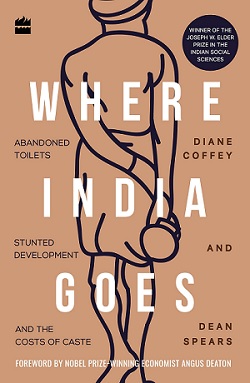India is a great country — the world’s largest democracy, the home of Bollywood, and even the record holder for most satellites launched on a single rocket. But there’s one dirty problem it’s got to solve: open defecation. Of the nearly 950 million people worldwide who defecate outdoors, 569 million are Indian. The problem isn’t simply lack of toilets due to poverty; it’s that casteism makes internationally acceptable pit latrines totally unacceptable to many Indians.
Over the years, Indian governments have helped build millions of latrines throughout India. But in many places, the structures — each essentially an outhouse enclosing a pit that has a place to squat over it — aren’t used for defecation and are instead used to store everything from tools to grain. When people need to poop, they head to fields or roadsides, leading to one of the world’s highest rates of open defecation.
The result: stunted children, infant mortality — at rates higher than expected relative to India’s level of development. As reported in the recent book Where India Goes: Abandoned Toilets, Stunted Development and the Costs of Caste, Indian babies have higher mortality rates than babies in Bangladesh and Nepal, which are both poorer than India but have lower open-defecation rates. Additionally, an Indian child is more likely to be stunted than one in sub-Saharan Africa.
Why the aversion to pit latrines?
The answer: Once pit latrines fill up, they have to be emptied. In no country is this a pleasant task, but in much of India there’s the added stigma of caste-related impurity. In the past, Dalits would empty latrines, but as they strive toward equality today, they avoid this stigmatized task, and thus the cost of emptying a latrine has risen. In an illuminating TED talk, Sangita Vyas of the Research Institute for Compassionate Economics (RICE) said, “People from middle and upper castes would find it inconceivable to empty a pit latrine by hand themselves. At the same time, people from lower castes tend to avoid doing such work, understandably, because it’s associated with their past and continuing oppression. So the market for pit emptying in India has completely broken down.”
In a recent article on Foreign Policy’s website, Diane Coffey and Dean Spears, both with RICE and the authors of Where India Goes, wrote, “Indian Muslims, who have different ideas about purity, pollution, and propriety than Hindus, are more likely to use latrines. Open defecation in Muslim neighborhoods is so much lower than it is in Hindu neighborhoods that Muslim children are more likely to survive infancy, despite being poorer.”
Indian Prime Minister Narendra Modi says India, through its Swachh Bharat Abhiyan (Clean India Mission), will end open defecation by Oct. 2, 2019 — Gandhi’s 150th birthday. As Gandhi’s 148th birthday approaches this year, Indians should, as Vyas said in her talk, “start having frank conversations about caste and about what caste has to do with sanitation. And we need to be experimenting like crazy with solutions that address people’s real concerns about pit emptying.”
* * *
Preeti Aroon (@pjaroonfp) is a Washington, D.C.-based copy editor at National Geographic and was formerly copy chief at Foreign Policy. She copyedited the August 2017 National Geographic article “A Place to Go,” which was linked in this post.













